-by Greg Hoots-
There are few of us that have never enjoyed a cold bottle of “soda pop” on a hot day. That simple pleasure has become a big business in the United States with revenue from the sales of soft drinks topping 100-billion dollars, annually.
While soda pop seems as American as apple pie and the 4th of July, in fact, the sweetened beverage was actually invented in the mid-1700s in England. In 1767 Joseph Priestley first developed a method for infusing carbon dioxide into water, creating a pleasant bubbly beverage. By the 1770s artificially created mineral waters were being marketed commercially in England, claiming to have medicinal benefits. In the late 18th century and early 19th century the first commercial machines which infused bubbles into water were popularized and improved, leading to the first tonic water sold solely for refreshment purposes.
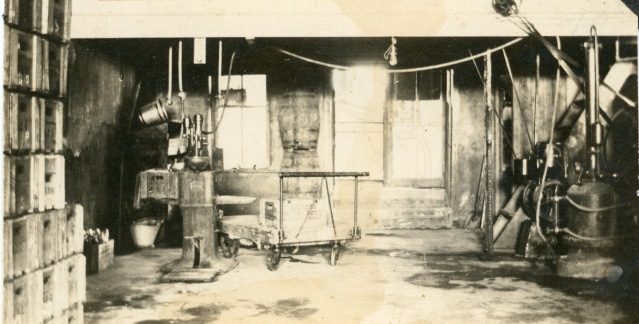
This is an interior view of the Burlington Bottling Works, Burlington, Kansas when it was being operated in 1913 by Henry and Ethel Falk, formerly of Alma.
With the acceptance of soda water as refreshment, a variety of sweeteners, flavorings, and syrups were added to the fizzing water to create a wide variety flavored, pleasant tasting beverages.
One of the greatest difficulties in the commercial popularization of soda water involved the bottling of the beverage. Because of the infusion of gas into the water, there was pressure within the bottle, requiring a perfectly sealed mouth from which the carbon dioxide could not escape. If the gas escaped from the bottled product, the drink would “go flat” and lose its pleasant taste.
The late 1800s saw a number of inventive improvements in the manufacture of glass bottles specifically designed for soda water. As important as the bottle was the design of the stopper, and a number of creative designs reached the market. One design had a “ladies leg” neck which contained a marble placed in the neck during bottle manufacturing. Once the liquid was placed in the bottle, the bottle was upended and the force of the carbonation pushed the marble into the lip of the bottle.

These drawings of the Hutchinson stopper were part of the patent application for the device.
Another creative design for a stopper called the Hutchinson Stopper was patented in 1879 utilized a rubber stopper attached to a wire ring which hung inside the neck of the bottle, and after the drink was poured into the bottle, the stopper was pulled into the neck of the bottle using the wire ring.

Patent Application, Bottle Sealing Device
A major improvement in the bottling of soda water was the invention in 1890 of the “crown top” by Irish immigrant William Painter. Painter, a professional inventor living in Baltimore, Maryland invented the thin metal cap with 21 teeth around its edge that was lined with a cork insert which was then forced onto the matching lip of the bottle while the edges of the teeth were crimped into place. Painter also invented a foot-powered crowning machine which sealed the metal crown onto the bottle without breaking the glass, and he sold these machines to the many bottling companies across the country.
The Alma Bottling Works has its origins in the early 1890s, the first reported operator of the business being Frank Loveland. The Alma Signal of April 16, 1892 stated, “Frank Loveland, proprietor of the Alma Bottling Works, has recently added to his establishment one of the finest bottling plants in the country. He informs us that Alma and neighboring towns will not suffer a pop famine the coming summer.” Two months later the Signal reports, “F. M. Loveland, proprietor of the Alma Bottling Works will run a feed store in connection with his soda water factory.” Loveland’s feed store and bottling works was located at 411 Missouri Street, in Alma, on the lot where the Carroll/Stuewe house would later be constructed.

This advertisement for Alfred Umbehr’s Alma Feed Store and Bottling Works appeared in an 1894 issue of the Alma Signal.
At the end of the 1892 soda pop season (at that time the bottling works only operated in the summer) Loveland sold his bottling works to Alfred Umbehr. The Alma Signal of October 15, 1892 reported, “Mr. Alfred Umbehr, formerly a resident of Alma, but later residing on his farm on Hendricks Creek, this week bought the bottling works and feed store formerly owned by F. M. Loveland, and will take charge of the same and run things in a first-class style.”
Umbehr operated his feed store and bottling works business until the spring of 1898 when he traded the enterprise to Alma businessman, and sometimes-carnival-roustabout, Guy Cleaveland for the latter’s racket store merchandise. The Alma Enterprise of May 13, 1898 reported, “Cleaveland traded his Racket store stock this week to Umbehr for his bottling works.” Cleveland began operating his bottling works in the former Umbehr feed store at 5th and Missouri which Umbehr had vacated when he moved to the Limerick building in 1897.
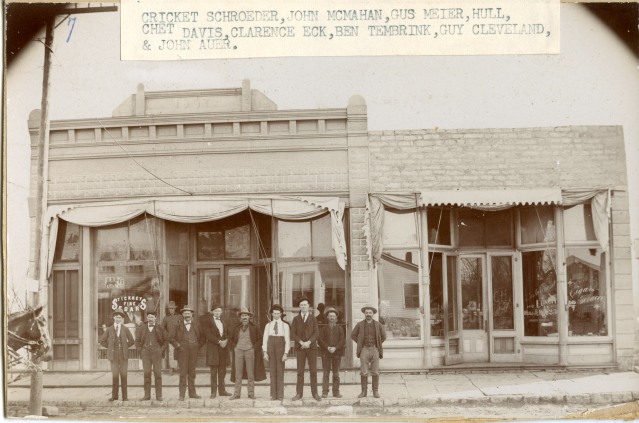
Guy Cleaveland, second from the right, operated the Alma Bottling Works from his feed store building located at 411 Missouri Street in Alma. Here, a group of Alma men stand in front of a cigar store located at 224 Missouri Street.
It was Guy Cleaveland who installed a cork-lined bottle-crowning system to Alma bottling works, installing the equipment in the spring of 1899. The Signal reports, “Mr. Guy Cleaveland is making preparations for a big trade in the products of his bottling works when spring opens. The Crown cork bottling process—a model of convenience and cleanliness—will be used, new machinery put in and everything done to enhance the value of the summer drinks to be manufactured at the works. Guy is a rustler and is deserving of that success of which he is assured.” The Alma Enterprise reported in the same month, “G. W. Cleaveland, proprietor of the Alma Bottling Works is making some improvements this spring that will place that prosperous concern right in the front row. There were added this week 72,000 new bottles, made especially for him at Alton, Ill. This is more than twice the number of the old bottles and will enable him to handle twice as much custom… His trade embraces a big scope of country; from Burlingame on the south to Wabaunsee on the north, west to Herington and east to Paxico.”
The next spring in April of 1900, the same paper declared, “Mr. Guy Cleaveland’s bottling works are running in full blast and the demand for his wares has so increased that he can hardly keep up the supply.”
At the end of the 1901 summer season, Cleaveland decided to leave Alma, and offered his business for sale. He placed this ad in the November 30, 1901 Signal, “For Sale—Having decided to go west I will sell my bottling works and feed mill at a bargain. Will sell separately or together. Will take cows as part payment. Call on or address Guy Cleveland [sic], Alma, Kansas.”
Cleaveland was unable to find a buyer for the enterprise, initially, and continued to operate the feed store and bottling works through 1902 and 1903. In May of 1903 A. F. “Frank” Breitenstein of Paxico, purchased half interest in the Alma Bottling Works, creating the partnership of Cleaveland and Breitenstein. The reported price paid by Breitenstein was $1,400. By the summer of 1903 the business supplied soda pop to towns throughout the county and neighboring counties. At the end of the 1903 summer season, Breitenstein sold his interest in the bottling works to John Woodward of Iowa. Woodward’s father was Judge Woodard of Alta Vista, and the younger Woodward began working at the bottling works preparing for the 1904 season. In the spring of 1904, Woodward was badly injured when his arm was caught in a flywheel of a large gasoline engine, and he operated the bottling works during the summer of 1904 only with great difficulty.
Cleaveland sold his remaining half-interest in the business to Henry and Ethel Falk. The Falks had operated a bottling works in Liberal and had recently sold it and returned to the Alma area.

Ethel Cahill Falk and her brother, Charles Cahill pose in front of the Liberal Bottling Works in the early 1900s.
In April of 1905 Woodward sold his interest in the bottling works to cattle and land baron, J. L. Schepp of rural Alma. Schepp hired W. Traugott and later, H. Holman to run the enterprise, and in May of 1905 Schepp had a new building constructed in the 1000 block of Ohio Street in Alma to house the bottling works on property owned by his mother Margaretha Muchlenbacher. Schepp operated the business for two seasons, before selling his bottling company and the property on which the bottling plant was located to James and Dorthea Barger of Argentine in the spring of 1907. The Falks sold their remaining interest in the business, as well, and the total reported price that the Bargers paid for the land and factory was $2,100.

J. L. Schepp advertised his newly acquired business, the Alma Bottling Works in a 1905 issue of the Alma Signal.
J. W. Barger expanded the company, offering a wider variety of favored drinks while expanding their market. He replaced the horse-drawn delivery wagon with a motorized truck and delivered his product regularly to stores throughout the area.
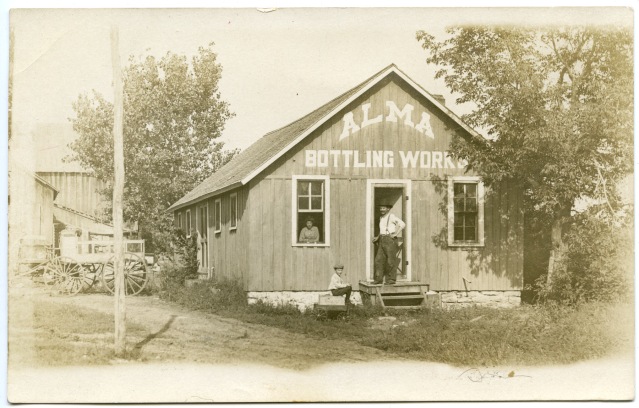
James Barger, in doorway, his wife, Dorthea, peering out the window, and their son, Norman, pose for this real photo postcard at their Alma Bottling Works plant in Alma, Kansas, circa 1908.
In 1909, the Bargers borrowed money from J.L. Schepp’s mother to construct a home on the lot where the bottling works building was located.

James and Dorthea Barger built this new home in the 1000 block of Ohio Street in Alma, Kansas in 1909. The Bargers purchased the lot for the house when they bought the Alma Bottling Works, visible in the background.
The Bargers operated the bottling works longer than any previous owner, growing the business for nine years before James Barger died suddenly in February of 1916.

J. W. Barger advertised his very successful Alma Bottling Works products in this Alma Signal newspaper, dated 1907.
Dorthea Barger vowed to continue to operate the bottling works after her husband’s death, but the work was overwhelming for the widow raising two children. By 1920 Barger had sold her Alma bottling works equipment to the Alma Ice and Electric Company which began bottling their brands of pop and for the first time, operating 12-months a year.

The Alma Bottling Works was operated by the Alma Ice and Electric Co. during the 1920s. One soda pop the company offered was named, “Howdy.”
By the end of World War II, national brands of soda pop began to dominate the market, and local bottlers could only compete with the likes of Coca-Cola and the many other national brands by offering their flavored drinks at a lower price than the name brands. By the end of the war, the Alma Bottling Works was no more.
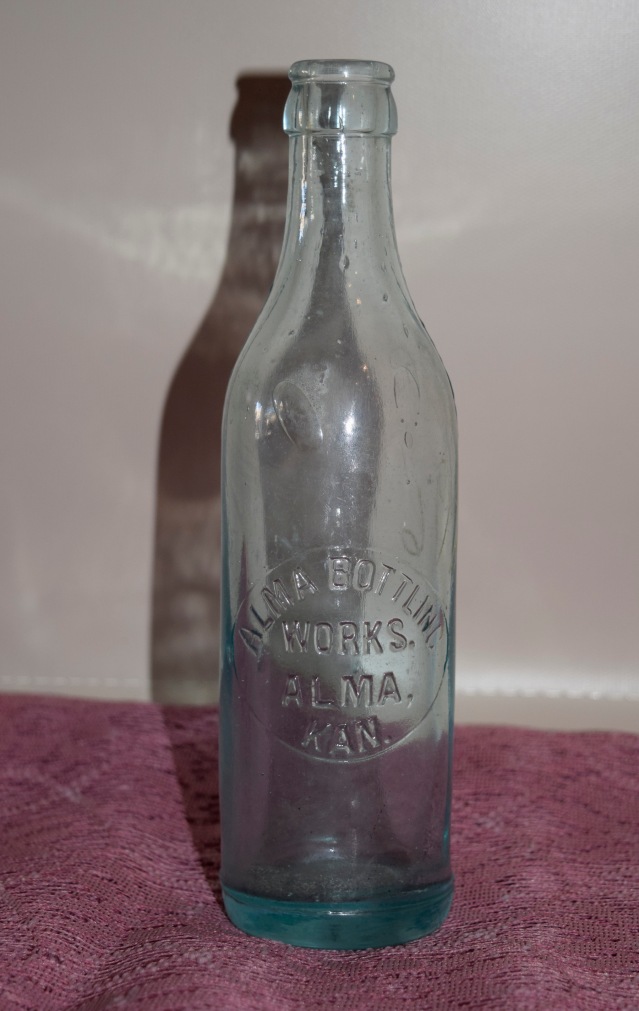
This crown-top pop bottle from the Alma Bottling Works, Alma, Kansas is on display at the Wabaunsee County Historical Society Museum in Alma, Kansas.
When Arnold Schmitz, grandson of Alma pioneer Henry Schmitz, returned from World War II to his hometown, he and his new bride, Iris purchased the Barger home on Ohio Street, which included the Alma Bottling Works building in the back yard. When interviewed by this author many years ago, Schmitz recalled that the home had no indoor plumbing. He remarked that plumbing fixtures and copper pipe were incredibly difficult to find immediately after the war, and recalled the excitement when he found a ceramic toilet and enough copper pipe to plumb an indoor bathroom in the house. Schmitz converted the bottling works building into a chicken house, and the young couple bought some laying hens. To transform the bottling works building to this agriculture purposes, Schmitz recalled hauling truckload after truckload of empty bottles to the city dump, located “down by the creek.”

This napkin ring was a promotional or advertising item of the Alma Bottling Works, Alma, Kansas.
Today, a few Alma Bottling Works bottles still survive, most held by private collectors or museums. Many are probably buried along with tons of other rubble discarded at the city dump. The Wabaunsee County Historical Society has three such bottles in their collection, as well as an unusual celluloid napkin ring which bears the business’s advertising.
Click on any image below to view in a gallery format or to be seen full-screen:
Categories: Blog, Early History, Featured Stories, Gallery

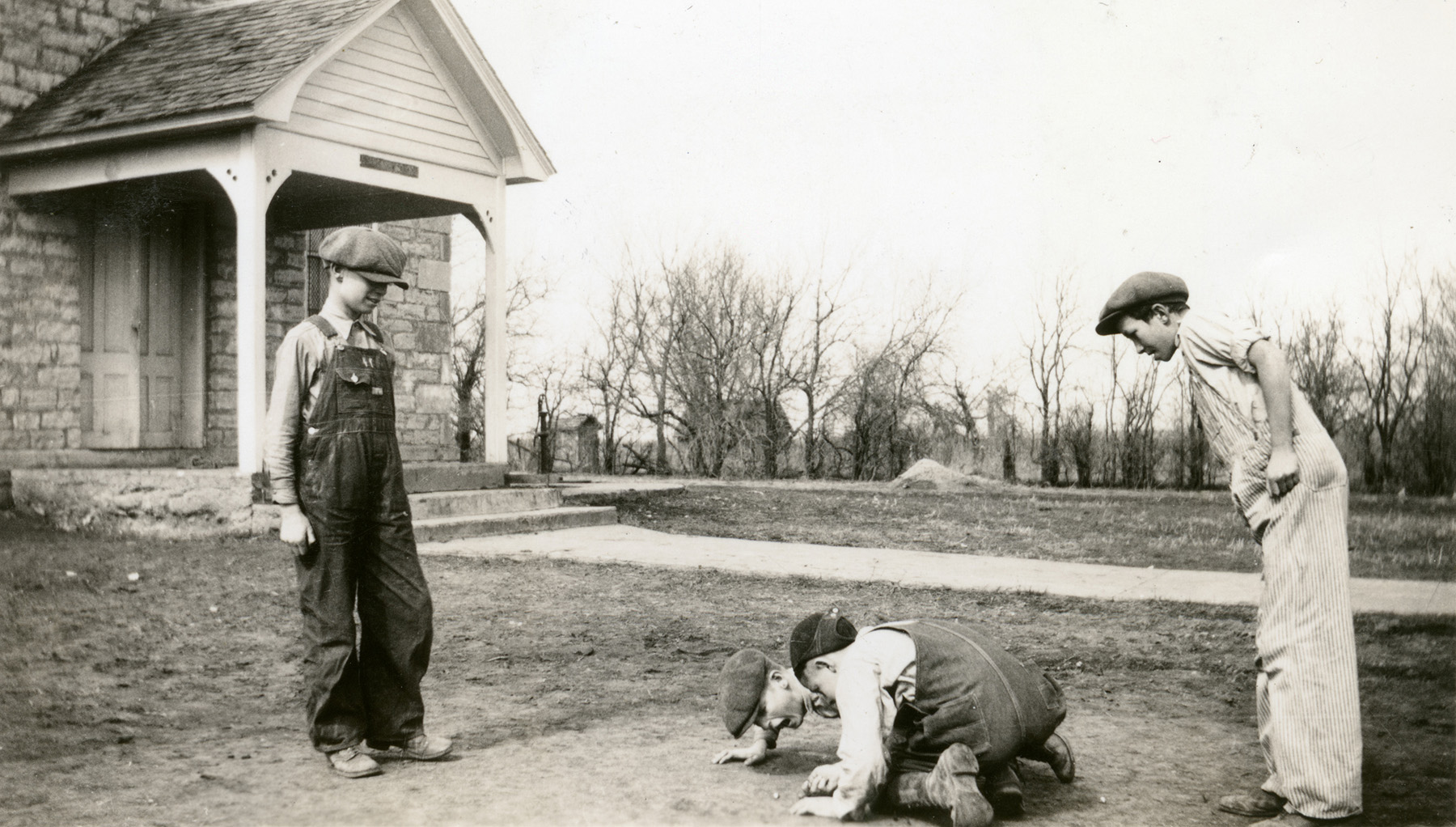

















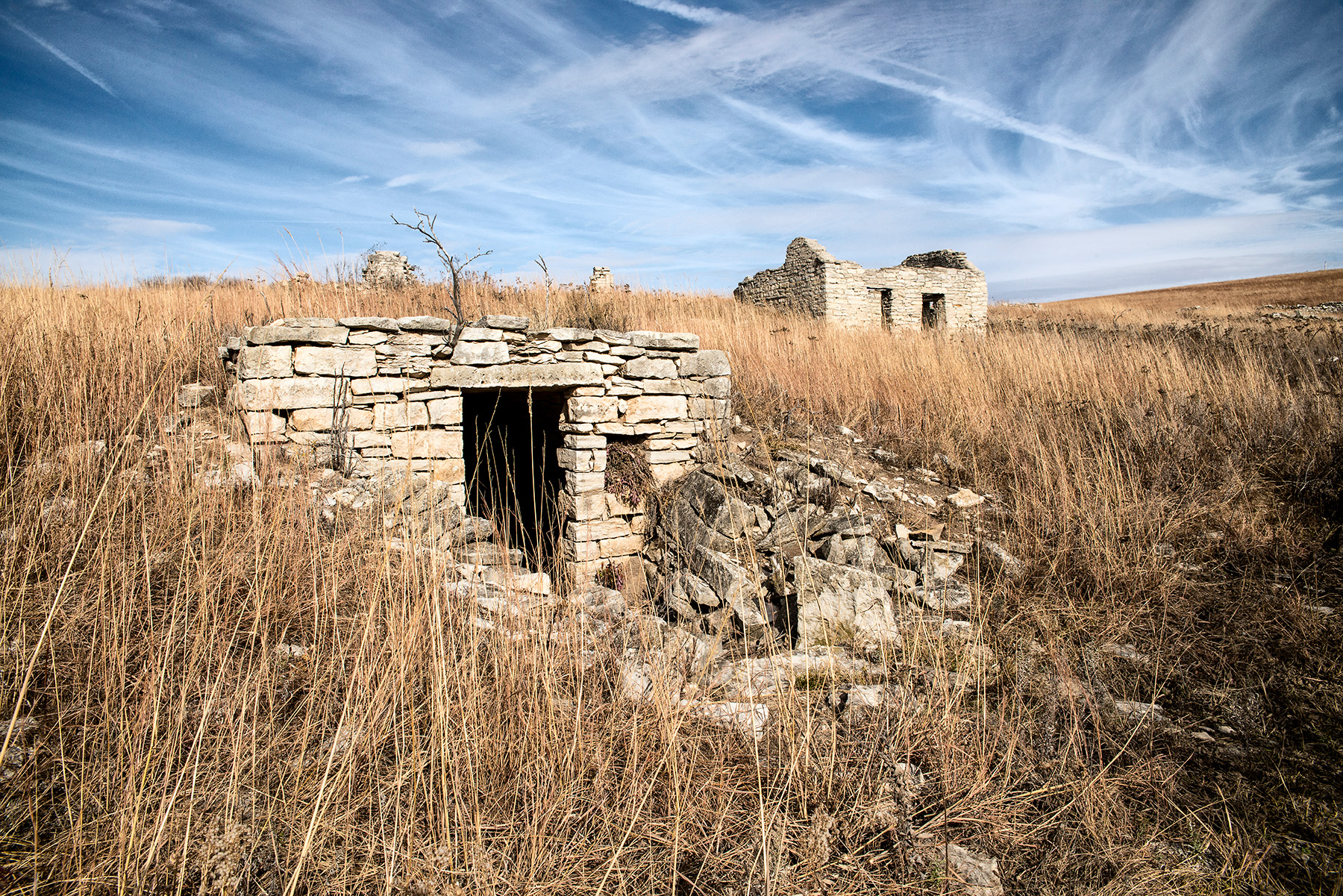
Excellent history. Thank you. William Painter’s “crown top” is still common today. Interesting how the first three owners of the Bottling Works purchased and sold the business quickly after 2, 6 and then 3 years which shows that yes, they were “rustlers” and energetic.
LikeLike